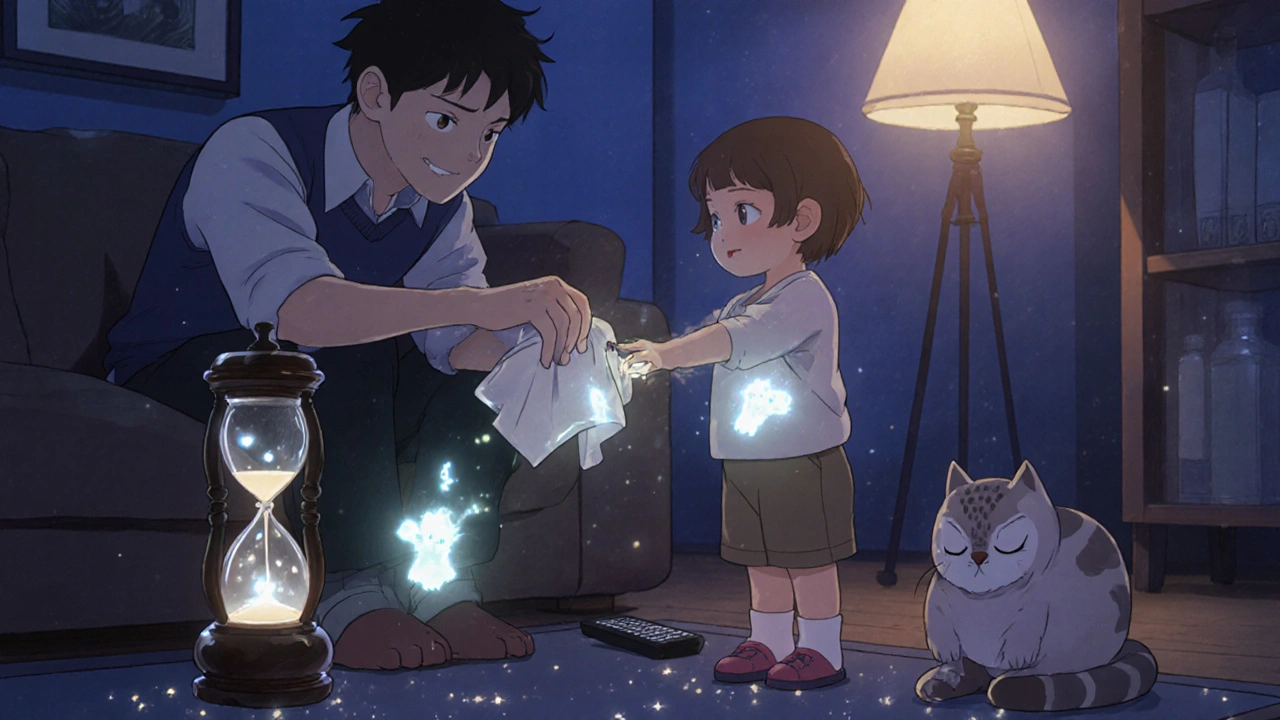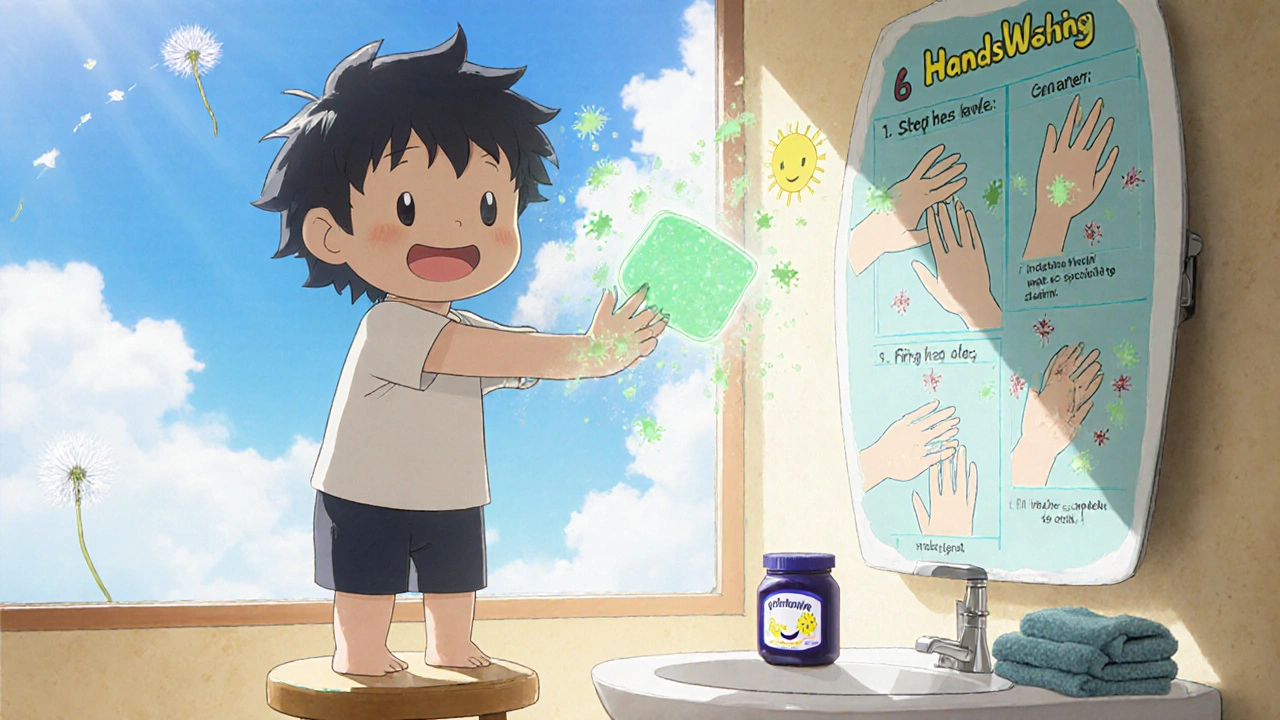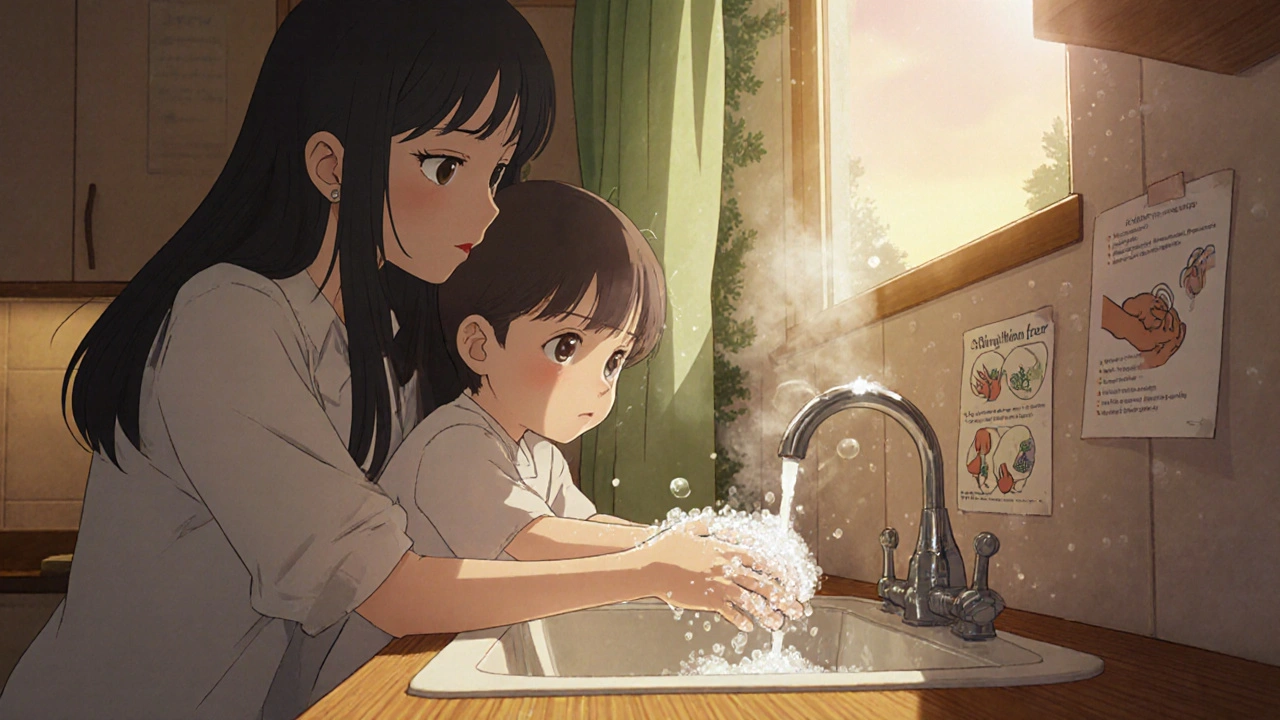Every time you touch a doorknob, pick up your phone, or help your kid wipe their nose, you’re handling germs-some harmless, others dangerous. But here’s the truth: hand hygiene is the single most effective way to stop those germs from spreading in your home. Not fancy gadgets. Not expensive cleaners. Just clean hands, done right.
Why Your Hands Are the Main Highway for Germs
Your hands touch everything: fridge handles, toilet flushes, pet fur, baby bottles, remote controls. And every time you do, you’re picking up or passing along bacteria and viruses. The numbers don’t lie. According to the CDC, proper handwashing reduces respiratory illnesses like colds and flu by 16-21% and cuts gastrointestinal infections like stomach bugs by 31% in households. That’s not a small win-it’s life-changing, especially if you have young kids, elderly relatives, or anyone with a weak immune system. Norovirus, for example, spreads like wildfire in homes. One infected person can make 16-28% of others sick just by touching the same surfaces. Influenza? A 3.2% chance of passing it to someone else in your home. SARS-CoV-2? Around 10% transmission rate among family members. These aren’t rare scenarios. They happen every winter, every flu season, every time someone comes home from school or work. The good news? You don’t need to be a scientist to stop this. You just need to wash your hands the right way.Soap and Water vs. Hand Sanitizer: What Actually Works
Most people think hand sanitizer is the better option. It’s quick, portable, smells nice. But here’s the catch: it’s not always the best tool for the job. Soap and water is the gold standard-especially when your hands are dirty, greasy, or after using the bathroom. Why? Because soap physically lifts germs and dirt off your skin and rinses them away. It’s the only method that works against tough bugs like norovirus and C. difficile spores. Alcohol-based sanitizers? They can’t touch those. Hand sanitizer shines when your hands aren’t visibly dirty. It kills 99.99% of enveloped viruses like flu and COVID-19 in under 15 seconds. But only if it’s at least 60% alcohol. Anything lower? It’s basically useless. And if your hands are grimy? Sanitizer drops to just 12% effectiveness. That’s worse than doing nothing. And forget antibacterial soap. The FDA banned triclosan and 18 other antibacterial ingredients in consumer soaps back in 2016 because they don’t work better than plain soap-and they might be making germs stronger. You’re paying extra for nothing.The 6-Step Handwashing Technique (And Why Most People Get It Wrong)
It’s not enough to just rub your hands together for five seconds while the sink runs. The World Health Organization’s 6-step technique is backed by decades of research. It’s designed to cover every surface of your hands-because germs hide in places you don’t think about. Here’s what you need to do:- Palm to palm
- Right palm over left back, interlace fingers, switch
- Palm to palm with fingers interlaced
- Backs of fingers to opposing palms with fingers locked
- Rotational rubbing of thumbs
- Rotational rubbing of fingertips in opposite palm
Water Temperature, Drying, and the Hidden Mistake Everyone Makes
You’ve probably heard that hot water kills more germs. Not true. A 2017 study in mSphere found water between 100-108°F (38-42°C) works best-but cold water (60°F/15°C) removes germs just as well. The real benefit of warm water? It helps dissolve grease and dirt. But if you’re worried about energy bills or scalding kids, cold water is perfectly fine. Now, here’s the biggest mistake most households make: touching the faucet after washing. The CDC found 89% of people turn off the tap with their clean hands-recontaminating them instantly. The fix? Use a paper towel to turn off the faucet. Or better yet, install a foot-pedal faucet. They cost $45-$120 to retrofit and eliminate this problem entirely. And don’t air dry. Drying with a paper towel reduces bacteria by 76% compared to hand dryers. It’s not just about drying-it’s about removing the last traces of germs.
When and Where to Wash: The 4 Critical Moments at Home
You don’t need to wash your hands 20 times a day. But there are four moments when it’s non-negotiable:- After coming home-This stops outside germs from spreading to your couch, phone, or kids.
- Before preparing food-This cuts foodborne illness risk by 78%, according to USDA data.
- After using the bathroom-Essential. Fecal germs are everywhere, and they’re easy to transfer.
- After touching pets-Pets carry germs that can make you sick. About 3.2 million zoonotic infections happen each year in the U.S. alone.
Getting Kids to Wash Properly (Without Screaming)
Kids hate handwashing. It’s boring. It takes too long. You’ve probably tried singing “Happy Birthday” and got a sigh. Try this: use a visual poster. The Minnesota Health Department has free 6-step handwashing charts in 24 languages. Print one, stick it on the bathroom mirror. Kids follow pictures better than instructions. Use a timer. Amazon reviews for handwashing sand timers are 4.2 out of 5 stars from over 1,800 reviews. One parent wrote: “My family went from 6 colds a year to 2.” Make it fun. Let them pick a soap with a fun scent. Or use glow-in-the-dark soap that shows where they missed spots. One 2021 AJIC study found UV light testing showed only 37% of people fully covered their hands-so seeing the gaps makes a difference.Skin Dryness? Here’s How to Fix It
Frequent washing can dry out your skin. If you’re washing 10+ times a day (like a nurse or parent of toddlers), you might get cracks, redness, or even dermatitis. The fix? Moisturize right after drying. A 2020 study in Dermatology Practical & Conceptual found applying lotion within 3 minutes of washing reduced skin irritation by 62%. Keep a small bottle by every sink. It doesn’t have to be expensive-just plain petroleum jelly or fragrance-free cream works. And skip the antibacterial soaps. They’re harsher on skin and don’t help.
The Bigger Picture: Why This Matters Beyond Your Home
Hand hygiene isn’t just about avoiding a cold. Dr. William Schaffner of Vanderbilt says proper handwashing prevents 1.8 million child deaths globally every year from diarrheal diseases. That’s not a statistic-it’s real kids. The ROI is insane. The CDC says it costs just $1.27 per person per year to maintain basic hand hygiene. The savings? $16 in healthcare costs per person. That’s a 1,200% return. And it’s scalable. The WHO’s global campaign reached 1.2 billion people. In Minnesota schools, the “Germ Buster” program cut absenteeism by 22%. In low-income areas, simple “tippy tap” handwashing stations-made from a bottle, string, and a stick-have cut water use by 90% while keeping people safe.What’s Changing in 2025
New tools are hitting the market. Smart soap dispensers like GOJO’s PURELL SMART DISPENSING SYSTEM now track usage and send alerts if someone skips washing. The NIH is funding a $15 million study to test “habit stacking”-linking handwashing to existing routines like brushing teeth or checking your phone. The WHO updated its guidelines in May 2024 to include modified techniques for homes with limited water. The CDC now embeds QR codes in its handwashing guides that link to video tutorials with over 2 million views. This isn’t going away. It’s getting smarter.Final Checklist: Are You Doing It Right?
Here’s your quick test:- Do you wash for at least 20 seconds?
- Do you cover all surfaces-fingertips, thumbs, between fingers?
- Do you use soap and water when hands are dirty or after the bathroom?
- Do you use 60%+ alcohol sanitizer only when hands are clean?
- Do you dry with paper towels and use one to turn off the faucet?
- Do you moisturize after washing if your skin feels dry?
- Do your kids know how to wash properly-and do they actually do it?
Is hand sanitizer as good as soap and water?
No-not always. Hand sanitizer works well for killing germs on clean hands, especially viruses like flu and COVID-19. But it doesn’t remove dirt, grease, or tough germs like norovirus or C. difficile. Soap and water is always the best choice when hands are visibly dirty or after using the bathroom.
Does water temperature matter when washing hands?
Not for germ removal. Cold water (around 60°F/15°C) removes germs just as well as hot water. Warm water helps dissolve grease, but if you’re washing after the bathroom or before eating, cold water is perfectly effective-and safer for kids and more energy-efficient.
What alcohol percentage should hand sanitizer have?
At least 60%. Anything lower won’t kill germs effectively. The optimal range is 60-80%. Check the label. If it doesn’t list the alcohol percentage, don’t use it. Many cheap or novelty sanitizers fall below this threshold.
Are antibacterial soaps better than regular soap?
No. The FDA banned triclosan and 18 other antibacterial ingredients in consumer soaps in 2016 because they offer no extra protection over plain soap. Worse, they may contribute to antibiotic resistance. Stick with regular soap-it’s cheaper, safer, and just as effective.
How can I get my kids to wash their hands properly?
Use visuals. Print a 6-step handwashing chart and put it on the mirror. Use a 20-second timer-sand timers work great. Let them pick a fun-smelling soap. Sing a short song together. Studies show visual aids increase compliance from 28% to 63% in children. Make it a routine, not a chore.
Why do I still get sick even though I wash my hands?
Handwashing reduces risk, but doesn’t eliminate it. Germs can spread through the air, contaminated surfaces you didn’t touch, or from someone who didn’t wash their hands. You’re still doing the right thing-just make sure you’re washing long enough, covering all areas, and drying properly. Also, avoid touching your face after touching shared surfaces like doorknobs or phones.
Is it safe to use hand sanitizer on babies?
Yes, but with caution. Use only when soap and water aren’t available. Apply a pea-sized amount and rub until dry. Don’t let babies put their hands in their mouths right after. Avoid alcohol-based sanitizers if your baby has sensitive skin or eczema. Always supervise use.


Hand sanitizer is a gimmick for people who don't want to wash properly. 🤦♂️ I work in a hospital and we use 70% alcohol gel between patients-but only when hands are clean. If you're handling raw chicken or changing a diaper? Soap and water. Period. 🧼 No exceptions. The CDC data is crystal clear: norovirus laughs at sanitizer. 🚫🧫
so i been washing my hands for 20 sec but i never did the finger between thing 😅 i thought just rubbing was enough... now i feel like a dummy but also kinda motivated to fix it
There’s something deeply human about this topic. We touch everything-and yet we rarely pause to consider what we’re carrying. Handwashing isn’t just hygiene-it’s a quiet act of care. For yourself. For your child. For the elderly neighbor who lives alone. It’s not about fear. It’s about tenderness. And yet, we treat it like a chore. Maybe that’s why so many skip it. We forget the love beneath the ritual. I started putting a little note on our bathroom mirror: ‘You’re worth the 20 seconds.’ My daughter started singing the song backwards now. She says it makes her laugh. And that’s when I knew-this wasn’t about germs anymore. It was about connection.
my 4 year old refuses to wash unless we play ‘germ monster battle’ with the soap. we use the glow-in-the-dark one and he goes full ninja mode. it works. no yelling. no tears. just soap suds and victory dances. also, i keep a tiny lotion bottle next to every sink now. dry hands = cracked skin = more germs. weirdly, self care and hygiene go hand in hand. literally.
Let me be clear: hand hygiene is not optional. It is non-negotiable. It is the most cost-effective, universally accessible, life-saving public health intervention ever devised. And yet, in this country, we treat it like a suggestion. We have smart dispensers, QR codes, WHO guidelines, CDC posters-and still, people touch the faucet with clean hands. Still, they use 30% alcohol gel bought on Amazon for $2. Still, they skip washing after pets. This isn’t ignorance. It’s negligence. And it’s costing lives. We need mandates. We need enforcement. We need to stop treating health like a personal preference.
While I appreciate the empirical rigor of the data presented, I must respectfully underscore that the cultural context of hand hygiene varies significantly across global communities. In many rural Indian households, for instance, water scarcity necessitates alternative methodologies such as ash-based cleansing, which has been empirically validated in peer-reviewed studies from the Indian Journal of Medical Research. Furthermore, the assumption that paper towels are universally accessible overlooks economic and infrastructural disparities. While the 6-step technique is scientifically robust, its implementation must be contextualized within local resource constraints to ensure equity and efficacy. A one-size-fits-all approach risks cultural imperialism under the guise of public health.
Wait-so you’re telling me I’ve been doing it wrong for 12 years? I thought singing ‘Happy Birthday’ once was enough. I’ve been using 40% sanitizer because it smells like mango. I didn’t know the FDA banned antibacterial soap. I didn’t know cold water works just as well. I didn’t know my kids were missing 68% of their fingertips. I just thought I was being ‘clean enough.’ This post just rewired my brain. I’m printing the chart. I’m buying a sand timer. I’m moisturizing. I’m turning off the faucet with a towel. I’m telling my whole family. Thank you. This isn’t just advice-it’s a wake-up call.
Oh great. Another guilt-trip from the hygiene police. Next they’ll make us wash our hands before breathing. I’ve never gotten sick from not washing after the dog. My grandma washed her hands in a bucket once a week and lived to 98. You’re overcomplicating simple living. And why are we trusting the CDC? They changed their mask advice 7 times. Who’s to say this isn’t just fearmongering dressed up as science?
They’re lying about water temperature. Cold water doesn’t kill germs. It’s a trick. The government wants us to use less energy so they can track us through smart faucets. And those glow-in-the-dark soaps? They’re nanotech. They’re embedding chips in your skin. Don’t fall for it. Wash with hot water. Use soap. Don’t trust the timer. And never, ever use paper towels-they’re coated with 5G poison. 🕵️♂️🔥